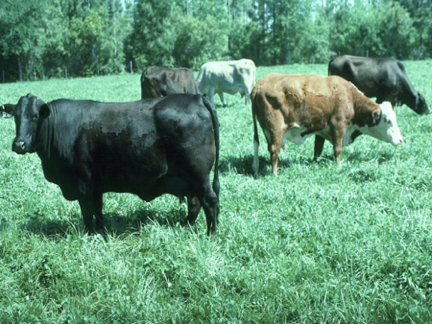
Minimizing the need for hay or other stored feed is a key to profitable forage/livestock production. Numerous strategies can be used to accomplish this, one of which is striving to match animal needs to forage quality. Different animal types and classes have different nutritional needs. Therefore, by having animals with higher nutritive requirements graze the best quality pasture forage or receive the best quality hay and/or supplements, and using lower quality material in the rations of animals with lower nutritive requirements, the benefits realized can be increased.
In particular, the nutritional needs of breeding female livestock vary greatly during the year, with the greatest nutritional demand occurring during early lactation. This means that animals being pastured have differing requirements for forage quality and quantity at various times. For example, in a beef cow/calf operation in which a late winter or spring calving schedule is employed, calves have high needs for energy and protein to make good gains in late summer, while dry, pregnant cows can be on a maintenance diet. Thus, at this time, calves should receive good quality pasture while cows can utilize lower quality hay or pasture.
Having a controlled breeding season, and calving at a time that allows animal nutritional needs to match the quality and quantity of available pasture forage, are keys to both good animal performance and minimizing supplemental feeding. Depending on calving dates, the ease of providing appropriate quality pasture forage may vary greatly. In a situation in which winter annuals can be easily grown, autumn calving (which lowers cow nutrient requirements in early spring) may work well. Late winter or spring calving may be more suitable for producers who rely primarily on cool season perennials. (Rebreeding during warm weather, especially if animals are grazing toxic endophyte tall fescue, will likely not work well.)
Forage testing is a tool livestock producers can use to make better use of their forage (pasture, hay, and/or silage). Knowing the quality of the forage available and matching forage quality to animal needs allows a livestock producer to ensure acceptable animal performance while minimizing supplementation. When pasture is running short and animals need energy supplementation, grain or by-products may be the most cost-effective supplement (obviously, the cost of energy supplements at the time is an important consideration).
Beginning to provide supplementation as pasture growth slows will ensure high energy and good animal response. This may make it possible to stretch use of pasture forage through the period of low production by lowering forage intake. This may keep a pasture from being overgrazed and subsequently being slow to recover.
There are practical limits to the amount of time, energy, and other resources a cattle producer will be willing to invest in matching animal nutritional needs and forage quality. However, this is a bona fide strategy for helping get the most benefit from forage produced. On many farms, increased emphasis on this opportunity could reap excellent results.
__________________
Foraging Ahead is a column presented by Ragan & Massey and written by Dr. Don Ball, Professor Emeritus at Auburn University. Dr. Ball is one of the authors of the popular book “Southern Forages,” which can be found via a computer search that uses the words, “Southern Forages, The Fertilizer Institute”
